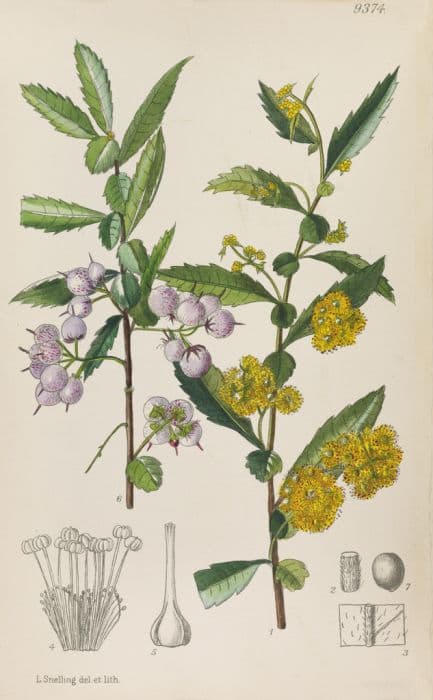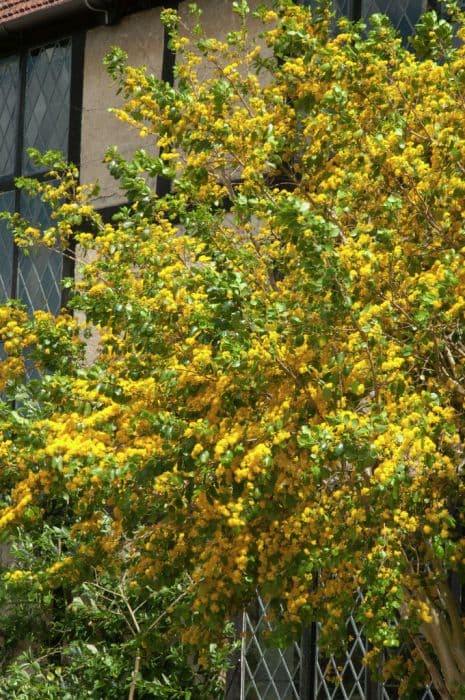Silver Creeping Willow Salix repens var. argentea

ABOUT
Salix repens var. argentea, commonly known as the silver creeping willow or simply silver willow, is a visually striking variety with distinctive foliage and form. This plant features slender, pliable branches that either creep along the ground or arch slightly upwards. The leaves of the silver creeping willow stand out with their silvery sheen which is due to a fine layer of silky hairs that cover them. This silver tone gives the plant a luminous quality, particularly when it catches the light. The leaves are typically elongated with margins that can be smooth or slightly serrated, presenting a narrow or lance-shaped profile. The plant bears catkins, which are a type of inflorescence common to willows, that appear in early spring. These catkins provide an early source of pollen for bees and other pollinating insects. The catkins usually have a soft, fluffy appearance and contrast nicely against the shimmering foliage. Silver creeping willow's visual appeal is rounded out during the growing season by the addition of new stems that have a reddish tinge, adding another layer of color and interest to the plant’s overall appearance. Due to its distinctive coloration and texture, this plant is often added to gardens and landscapes where it can serve as ground cover or link other garden features by creating a silver carpet effect when several specimens are planted together.
About this plant
 Names
NamesFamily
Salicaceae
Synonyms
Silver-Leaf Willow, Silver Creeping Willow, Silky Willow, Silvery Sallow
Common names
Salix arenaria, Salix argentea, Salix repens ssp. argentea
 Toxicity
ToxicityTo humans
Salix repens var. argentea, commonly known as the Creeping Willow, does not have a widespread reputation for being toxic to humans. Members of the Salix family are generally not considered poisonous and are often known for containing salicin, a compound that is related to aspirin. However, as with many plants, individual sensitivities can vary, and there may be some mild irritation if sensitive individuals come into contact with plant parts and then touch their face or eyes. Ingesting any part of the Creeping Willow is not commonly associated with severe toxicity in humans, but it is generally advised to avoid consuming plants that are not explicitly determined to be edible due to potential individual allergic reactions or possible contamination with pesticides or other chemicals.
To pets
Salix repens var. argentea, also known as the Creeping Willow, is generally considered non-toxic to pets. Canine and feline species can quite often tolerate the ingestion of small quantities of willow bark or leaves, which can contain salicin, a chemical precursor to aspirin. However, in large amounts or in certain cases, the ingestion of parts of the Creeping Willow could potentially cause gastrointestinal upset, including vomiting or diarrhea. As with any non-food plant, pet owners should deter their pets from consuming large quantities to avoid any potential stomach discomfort or more serious complications in rare cases of sensitivity or allergy. Always consult with a veterinarian if you notice any adverse reactions in your pet after ingesting this or any other plant.
 Characteristics
CharacteristicsLife cycle
Perennials
Foliage type
Deciduous
Color of leaves
Green
Flower color
Yellow
Height
1-2 feet (30-60 cm)
Spread
2-4 feet (60-120 cm)
Plant type
Shrub
Hardiness zones
4
Native area
Europe
Benefits
 General Benefits
General Benefits- Erosion Control: Salix repens var. argentea has a robust root system that helps stabilize soil and prevent erosion.
- Habitat Provision: It provides shelter and nesting sites for birds and other wildlife.
- Landscape Aesthetics: The silvery foliage adds a unique visual interest to gardens and landscapes.
- Windbreak: It can serve as a protective barrier against strong winds when planted in rows or hedges.
- Drought Tolerance: Once established, it can withstand periods of drought, making it suitable for xeriscaping.
- Soil Improvement: Its roots can improve soil structure and fertility through nutrient cycling.
- Adaptability: The plant is adaptable to a range of soil types, including sandy and salty soils.
- Cultural Significance: It may have historical or cultural importance in certain regions or among certain communities.
- Low Maintenance: Requires minimal care once established, making it a convenient choice for landscapers and gardeners.
 Medical Properties
Medical Properties- Salicylic acid precursor: Salix repens var. argentea contains salicin, which can be converted to salicylic acid in the body. Salicylic acid has analgesic and anti-inflammatory properties.
- Anti-rheumatic: Traditionally, compounds from willow bark, the family to which Salix repens belongs, have been used to treat rheumatic pain and inflammation.
- Antipyretic: Salicin from willow species has been used historically to help reduce fever.
- Anti-inflammatory: The plant has been known to possess compounds with potential to reduce inflammation.
 Air-purifying Qualities
Air-purifying QualitiesThis plant is not specifically known for air purifying qualities.
 Other Uses
Other Uses- Silver creeping willow can be planted to stabilize sand dunes and prevent erosion due to its dense root system and tolerance to sandy soils.
- Its flexible twigs can be used in basketry and traditional weaving practices, often by soaking them to increase pliability before use.
- The plant serves as a food source for butterfly caterpillars, including the purple emperor butterfly, making it valuable for butterfly gardens.
- Silver creeping willow can be utilized in bonsai culture, where its small size and attractive leaves make it a unique choice for miniature landscapes.
- Because of its tolerance for wet conditions, it can be used in rain gardens to help manage runoff and improve water quality.
- This willow species provides cover and nesting sites for birds, particularly in marshy or coastal areas, aiding in the support of local biodiversity.
- The silver foliage of the plant can be used in ornamental garden designs to provide contrasting color and texture among other plants.
- Its ability to grow in poor soil makes it ideal for reclaiming and vegetating disturbed lands such as former industrial sites or mines.
- Silver creeping willow's dense growth habit can be exploited for privacy screening or to create a natural barrier in landscaping.
- Craftsmen may use the wood of the silver creeping willow to create small wooden sculptures or for intricate wood carving work.
Interesting Facts
 Feng Shui
Feng ShuiThe Creeping Willow is not used in Feng Shui practice.
 Zodiac Sign Compitability
Zodiac Sign CompitabilityThe Creeping Willow is not used in astrology practice.
 Plant Symbolism
Plant Symbolism- Flexibility - Salix repens var. argentea, commonly known as the Creeping Willow, displays remarkable flexibility in its branches, symbolizing adaptability and resilience in facing life's challenges.
- Growth - Like many willows, the Creeping Willow's vigorous growth habit signifies continuous growth and personal development.
- Healing - Traditionally, willow barks have been used for medicinal purposes, which makes the Creeping Willow a symbol of healing and recovery.
- Protection - In folklore, willows are often planted near homes to offer protection, so the Creeping Willow can represent safety and shelter.
- Sorrow - Willow trees are often associated with sadness or mourning, stemming from their weeping form; thus, the Creeping Willow may symbolize sorrow or empathy towards others' grief.
 Water
WaterThe Silver Creeping Willow prefers consistently moist soil, so it’s important to water it when the top inch of soil becomes dry to the touch, typically about once a week. During the growing season in spring and summer, you might need to water more frequently, especially in hot, dry weather. Depending on the size of the plant and the environmental conditions, this could mean using approximately 1 to 2 gallons of water per week. Reduce watering in the fall and winter when the plant’s growth slows down. Always ensure that the plant has good drainage to prevent waterlogging, which can cause root rot.
 Light
LightThe Silver Creeping Willow thrives best in full sun to partial shade conditions. It should be placed in a location where it receives at least 4 to 6 hours of sunlight daily. While it can tolerate some shade, too little light may lead to sparse growth and fewer catkins. The ideal spot for the Silver Creeping Willow would be an open garden area with plenty of direct sunlight in the morning and some shade during the peak afternoon hours to protect it from intense heat.
 Temperature
TemperatureThe Silver Creeping Willow is hardy and can tolerate a wide range of temperatures, but it grows best in conditions between 50°F and 75°F. It can survive minimum temperatures down to around -20°F, making it suitable for USDA hardiness zones 4 through 8. Avoid placing it in areas where temperatures frequently exceed 90°F, as excessive heat may stress the plant.
 Pruning
PruningPruning the Silver Creeping Willow is beneficial for shaping the plant, encouraging healthy growth, and removing dead or damaged branches. Prune in late winter or early spring before new growth begins, cutting back last year’s growth to maintain the desired size and form. It is often recommended to prune up to one-third of the older stems to encourage new shoots to develop. The best time for major pruning is in the dormant season to avoid sap bleeding.
 Cleaning
CleaningAs needed
 Soil
SoilCreeping willow (Salix repens var. argentea) prefers a well-draining soil mix with a slightly acidic to neutral pH of 6.0 to 7.0. A mix consisting of peat, loamy soil, and sand in equal parts should provide the right balance. Adequate organic matter will help with moisture retention while allowing excess water to drain away.
 Repotting
RepottingCreeping willow should be repotted every 2-3 years to ensure it has enough room for growth and to replenish nutrients in the soil. The frequency of repotting can vary depending on the growth rate and the size of the container.
 Humidity & Misting
Humidity & MistingCreeping willow thrives in moderate to high humidity levels but is quite adaptable and can tolerate lower humidity. Aim for a relative humidity around 40-60% for optimal growth conditions.
 Suitable locations
Suitable locationsIndoor
For indoor creeping willow, ensure bright light and moist soil.
Outdoor
Plant outdoor creeping willow in sun/partial shade and moist soil.
Hardiness zone
4-8 USDA
 Life cycle
Life cycleSalix repens var. argentea, commonly known as Silver-leaf Willow, starts its life cycle with seed germination, triggered by warmth and moisture in spring. The seedlings develop into juvenile plants with roots, stems, and leaves as they harness sunlight through photosynthesis to grow. As the plant matures, it undergoes vegetative growth, spreading through rhizomes and producing a dense mat of foliage. Sexual reproduction follows, with Silver-leaf Willow presenting catkins—males with yellow anthers and females with greenish styles—that are usually pollinated by wind. After pollination, female catkins produce small capsules containing numerous tiny seeds that are dispersed by wind or water. The plant’s life cycle can complete within a single growing season although the willow itself is a perennial, living for several years and going through multiple reproductive cycles.
 Propogation
PropogationPropogation time
Early spring
The most popular method of propagating Silver Carpet, or Salix repens var. argentea, is through stem cuttings. This is often done in late winter or early spring before new growth begins. Select healthy, young shoots from the plant and trim cuttings of about 6 to 8 inches (15 to 20 centimeters) in length. Each cutting should have several leaf nodes. Dip the cut end in rooting hormone to increase the chance of successful rooting. The cuttings can then be placed in a pot filled with a blend of peat and perlite or sand to provide good drainage. The medium should be kept consistently moist but not waterlogged, and the pot should be placed in a warm, bright area without direct sunlight. Roots typically develop within 4 to 6 weeks, after which the cuttings can be potted on or planted out.









